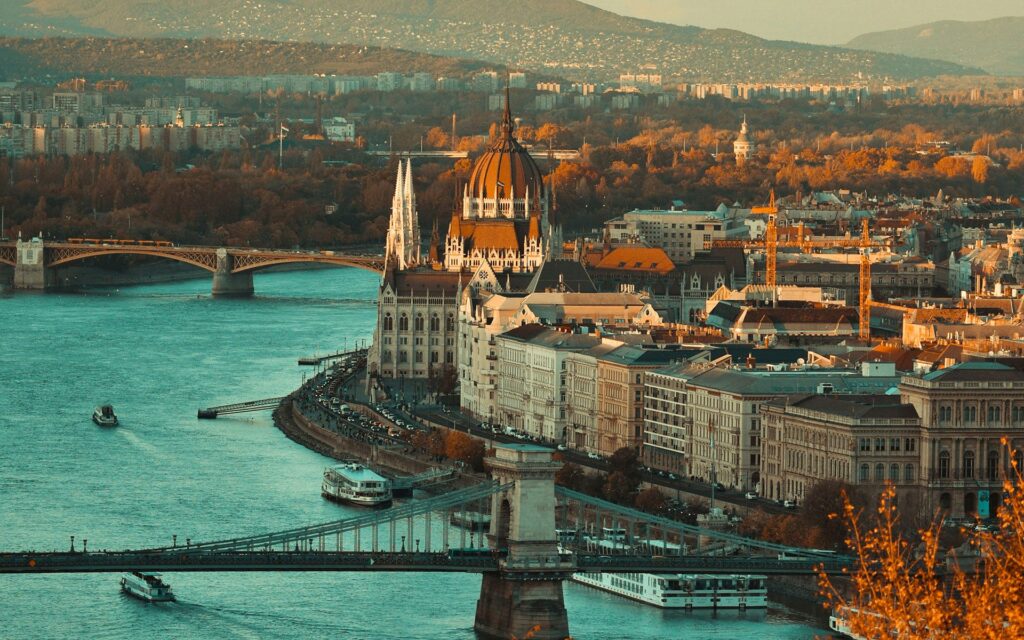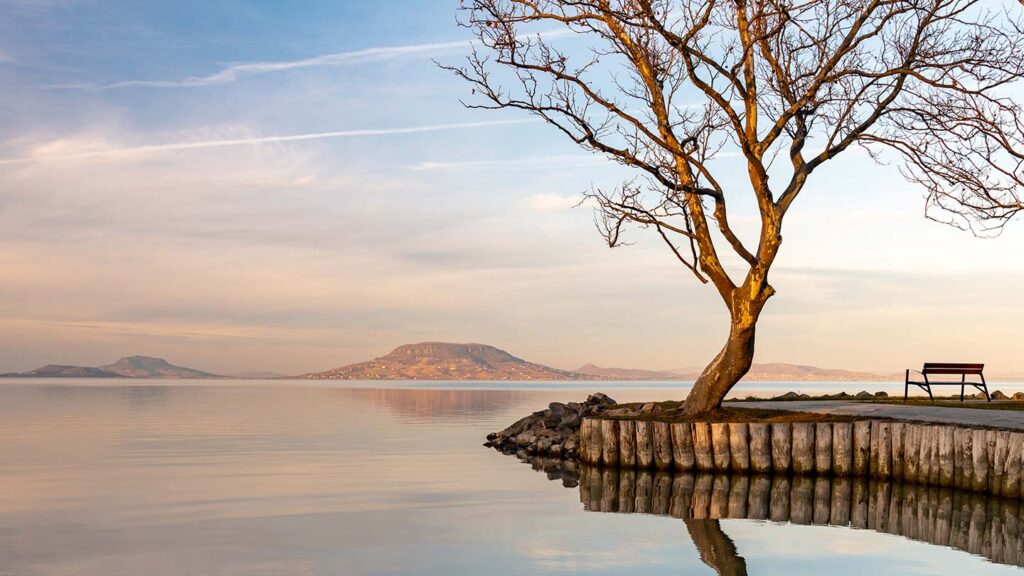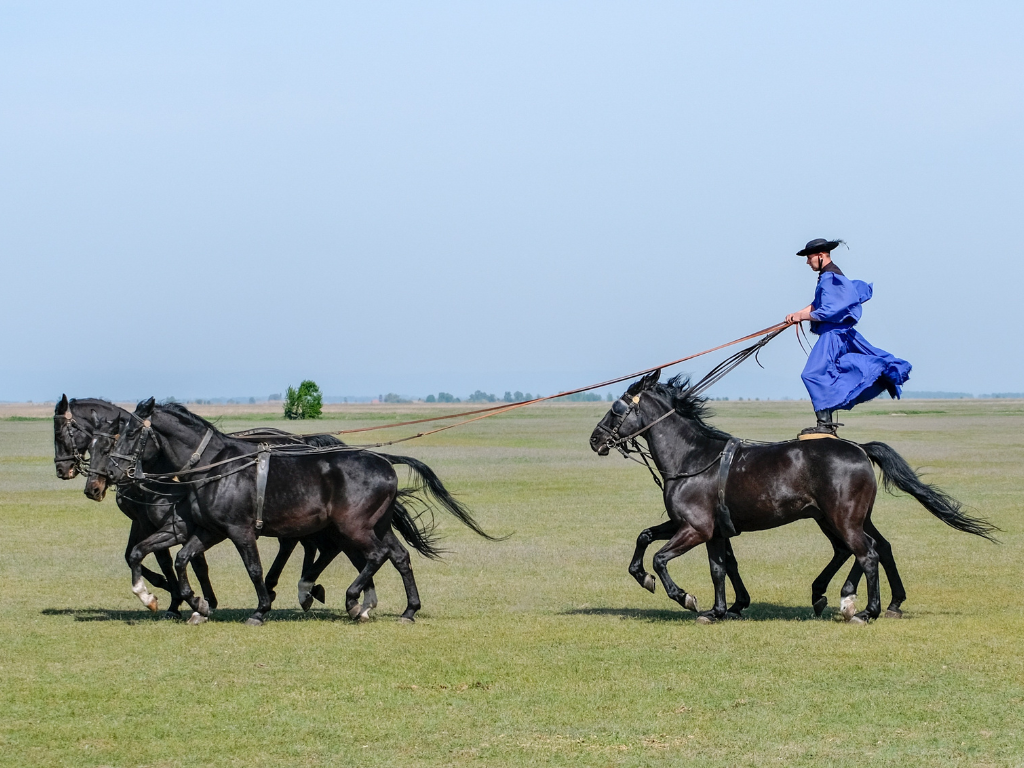From spa culture and storybook castles to paprika-rich cuisine and peaceful countryside towns, Hungary offers a rich mix of experiences – especially once you venture beyond Budapest. Whether you’re soaking in a steamy Szechenyi thermal bath or wandering the cobbled lanes of a riverside village, these are the 10 best places to visit in Hungary to get a real taste of the country.
Planning to visit Hungary? We run a range of guided trips that let you explore the country’s top spots – and a few hidden ones too. Browse your Hungary tour options with Trafalgar.
1. Budapest
The capital is the obvious starting point, but Budapest earns its place on any list of the best places to visit in Hungary. It’s got grandeur, grit, and more thermal baths than any other city in the world. Highlights include the regal Buda Castle on Castle Hill, the neo-Gothic Parliament building, and the famous Chain Bridge that connects Buda and Pest across the Danube.
For sweeping views, climb to the fairytale Fisherman’s Bastion. And no visit would be complete without a soak at the Szechenyi Thermal Bath, where you can float in steaming outdoor pools surrounded by 20th-century architecture.


2. Eger
Located in northern Hungary, Eger is known for its dramatic castle, Ottoman minaret, and delicious red wines (including the famous Bull’s Blood blend). The baroque old town is one of Hungary’s prettiest, with pastel facades and bustling café-lined squares. Its castle is famed for holding off the Ottoman siege of 1552. Wine lovers will want to spend time in the Valley of the Beautiful Women, tasting Egri Bikavér (Bull’s Blood) and visiting cellars carved into the hillsides. The city also houses quirky bits of pop culture — for example the Egri Road Beatles Museum celebrates the Beatles in Eger.


3. Lake Balaton
Lake Balaton, Hungary’s largest freshwater lake, is often called the “Hungarian Sea” – a favourite summer escape for locals thanks to its sandy beaches, wine cultivation, and sailing towns. The northern shore is known for rolling vineyards, hilltop vistas, and the Benedictine monastery of Tihany, where lavender fields bloom in summer. Though, in the summer months make sure to also head to the south shore, especially around Siófok, which becomes a hub for watersports, beachside cafés, and lively promenade walks. Even outside of summer, Balaton offers a refreshing escape from city life and is one of the best places to visit in Hungary for combining nature, wine culture, and tranquil lakeside time.


4. Szentendre
Just north of Budapest lies Szentendre, a pastel-painted riverside town with an artistic soul. Meander galleries, café terraces, and artisan workshops. A top attraction here is the Hungarian Open-air Museum (Skanzen), where traditional rural houses, farmsteads, and artifacts from across Hungary’s regions are assembled in immersive exhibits. The Urban Public Transport Museum is another gem, located in a restored depot and full of vintage trams and buses.


5. Pécs
In Hungary’s south, Pécs offers a sun-kissed Mediterranean feel, rich in history, art, and architecture. It’s home to the Early Christian Necropolis, a UNESCO-listed site of tombs and mausoleums from the 4th century. The Zsolnay Cultural Quarter revives the city’s famed porcelain tradition, with galleries, workshops, and ceramic displays lining the streets. Climb to the Pécs TV Tower on Misina Peak for sweeping views of the city and region. Additionally, architectural markers from various eras — Roman, Turkish, Christian — make Pécs a cultural mosaic.


6. Hollókő
A step back in time, Hollókő is a UNESCO-listed living folk village where traditions live on. The village’s layout, annual festivals, and cultural preservation make it one of Hungary’s most faithful links to tradition. Locals still wear Palóc folk costumes and host seasonal events like Easter celebrations in the village square. Think thatched-roof houses, embroidered costumes, and wood-fired bread. It’s also one of the best places to visit in Hungary if you’re looking to experience rural life.


7. Debrecen
In eastern Hungary, Debrecen is the nation’s second city and a hub for the Great Plain region. The Great Reformed Church stands as a Calvinist symbol, and the city’s museums reflect both local and national heritage. You can explore the city’s museums, parks and squares, then relax in the nearby thermal spas like Aquaticum – another reminder that Hungary takes its bathing seriously. Nearby lies Hortobágy National Park, often called the Puszta: endless grasslands, traditional herdsmen (csikós), seasonal bird migrations and open skies. It’s one of Europe’s largest meadow ecosystems and a contrasting natural experience to Hungary’s urban and wine zones.


8. Győr
Tucked between Budapest and Vienna, Győr is a beauty with a relaxed pace and fascinating history. It’s a Baroque treasure in the shape of a city, with Bishop’s Castle, graceful churches, and the old town’s winding lanes. It’s also one of the oldest cities in Hungary, dating back to Roman times. Because of its location at the confluence of three rivers, Győr also offers a pleasant base for exploring western Hungary or venturing across the Slovak–Austrian border.


9. Tokaj
Wine lovers, take note. Tokaj is one of the world’s oldest classified wine regions. The region’s volcanic soils, river mists, and centuries-old cellars create the perfect conditions for botrytised dessert wines and the famed Tokaji Aszú, once dubbed “wine of kings.” Wine cellars—some centuries old—dot the hillsides. Tasting rooms, winery tours, and vineyard walks make this area one of the top reasons to visit Hungary for wine lovers. Visit Hungary’s northeast to taste this golden nectar straight from the source.


10. Budapest at Christmas
Technically a repeat, but worth it – because Budapest truly transforms in winter. The Christmas Markets at Vörösmarty Square and the Basilica are some of the best in Europe, with wooden stalls selling mulled wine, handmade gifts and chimney cakes. There’s a skating rink in City Park and festive lights lining the Danube promenade. If you’re planning to visit Hungary in December, don’t miss the magic of the capital at Christmas.


RELATED CONTENT: 8 reasons to visit Hungary
What is the best time to visit Hungary?
Late spring to early summer (May–June) and early autumn (September) offer mild weather, fewer crowds, and ideal conditions for both city exploration and countryside tours.
How many days do I need in Hungary?
To cover Budapest plus a few extended destinations like Eger or Pécs, plan for 7–10 days. If you focus only on Budapest, 3–4 days suffice.
What should I pack for Hungary?
Bring layered clothing (summers are warm, winters cold), comfortable walking shoes, swimwear for baths, and a portable umbrella. In winter, pack a warm coat and gloves.
Want to see more than just one city? Book a guided tour to Hungary and we’ll take care of the planning – so all you have to do is explore.